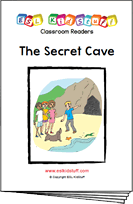[hide_on_uk]Favorites[/hide_on_uk][hide_on_us]Favourites[/hide_on_us] and asking why lesson plan
Stand-alone lesson ESL kids lesson plan
Lesson plans for ESL kids teachers
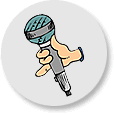
[hide_on_uk]Favorites[/hide_on_uk][hide_on_us]Favourites[/hide_on_us] and asking why
In this lesson, students practice saying what their [hide_on_uk]favorite[/hide_on_uk][hide_on_us]favourite[/hide_on_us] things are and explain why they like them using common adjectives. They play an adjective game and ask a classmates questions from a questionnaire.
Members get accompanying worksheets and classroom reader.
Download materials:
Our lesson plans are FREE!
Sign up for accompanying:
✔ worksheets
✔ homework sheets
✔ craft sheets
✔ flashcards
✔ song downloads & videos
✔ classroom readers & videos
Click to see lesson details, materials and supplies
Time: 40 mins – 1 hour
Objectives: Talking about favorites and explaining why.
Structures: “What is your [hide_on_uk]favorite[/hide_on_uk][hide_on_us]favourite[/hide_on_us] / least [hide_on_uk]favorite[/hide_on_uk][hide_on_us]favourite[/hide_on_us] …?”, “Why is it your [hide_on_uk]favorite[/hide_on_uk][hide_on_us]favourite[/hide_on_us] / least [hide_on_uk]favorite[/hide_on_uk][hide_on_us]favourite[/hide_on_us] ?”, “Because it is (adjective)”, “Really?”, “Oh yeah?”, “Oh yes?”, “OK”, “Oh right”
Target vocabulary: [hide_on_uk]favorite[/hide_on_uk][hide_on_us]favourite[/hide_on_us], least [hide_on_uk]favorite[/hide_on_uk][hide_on_us]favourite[/hide_on_us], why, food, [hide_on_uk]video game[/hide_on_uk][hide_on_us]computer game[/hide_on_us], animal, sport, book, school subject, [hide_on_uk]movie[/hide_on_uk][hide_on_us]film[/hide_on_us], [hide_on_uk]TV show[/hide_on_uk][hide_on_us]TV programme[/hide_on_us], game, drink, cartoon character, [hide_on_uk]color[/hide_on_uk][hide_on_us]colour[/hide_on_us], chocolate, [hide_on_uk]potato chip[/hide_on_uk][hide_on_us]crisps[/hide_on_us] [hide_on_uk]flavor[/hide_on_uk][hide_on_us]flavour[/hide_on_us], actor, author, sports player, vegetable, fruit, [hide_on_uk]comic book[/hide_on_uk][hide_on_us]comic[/hide_on_us], magazine, dessert.
Lesson materials
Printables:
- [hide_on_uk]Favorites[/hide_on_uk][hide_on_us]Favourites[/hide_on_us] questionnaire
- Why? Adjectives worksheet
- Family [hide_on_uk]favorites[/hide_on_uk][hide_on_us]favourites[/hide_on_us] questionnaire
- Reader worksheet
Readers:
- Andre asks
Additional materials:
- [hide_on_uk]Favorites[/hide_on_uk][hide_on_us]Favourites[/hide_on_us] and asking why vocab crossword
- [hide_on_uk]Favorites[/hide_on_uk][hide_on_us]Favourites[/hide_on_us] and asking why vocab word search
- [hide_on_uk]Favorite[/hide_on_uk][hide_on_us]Favourite[/hide_on_us] things and why worksheet
Supplies:
- [hide_on_uk]colored[/hide_on_uk][hide_on_us]coloured[/hide_on_us] pencils
- toy microphones or hand-made microphones made out of cardboard (optional)
- board with marker / chalk
This lesson allows students to talk about their [hide_on_uk]favorite[/hide_on_uk][hide_on_us]favourite[/hide_on_us] and least [hide_on_uk]favorite[/hide_on_uk][hide_on_us]favourite[/hide_on_us] things. Students are then asked why they like/dislike these things and their answers include adjectives.
Make sure you have already taught the likes & dislikes lesson before teaching this lesson.
We can use “[hide_on_uk]favorite[/hide_on_uk][hide_on_us]favourite[/hide_on_us]” and “least [hide_on_uk]favorite[/hide_on_uk][hide_on_us]favourite[/hide_on_us]” to say the things we like and dislike the most:
- My [hide_on_uk]favorite[/hide_on_uk][hide_on_us]favourite[/hide_on_us] food is pasta.
- My least [hide_on_uk]favorite[/hide_on_uk][hide_on_us]favourite[/hide_on_us] singer is Justin Bieber.
We can also ask for opinions using “favorite” with Wh questions:
- What is your [hide_on_uk]favorite[/hide_on_uk][hide_on_us]favourite[/hide_on_us] food?
- Who is your least [hide_on_uk]favorite[/hide_on_uk][hide_on_us]favourite[/hide_on_us] singer?
Lesson procedure:
Warm up and maintenance:
The beginning of your lesson is extremely important: this is where you set the tone of your lesson and get everyone in the right frame of mind for learning English. It is also an opportunity to check homework and review previous lessons.
Click for warm up suggestions for the start of your lessons
These activities can be done in the following order at the start of your lesson:

1. Greetings and name tags
Greet the students by name as they enter the classroom and gesture for them to sit down. Before class prepare some blank name tags (stickers or pin-on tags). Give these out and have everyone write their names and put their tags on. If you use pin-on tags, you can keep and give out every class.

2. Homework check
Check each student’s homework set in the last lesson. Ask each student some questions about their homework worksheet (e.g. “what [hide_on_uk]color[/hide_on_uk][hide_on_us]colour[/hide_on_us] is it?”), give lots of praise, and then put some kind of mark on the homework sheet (e.g. a sticker, a stamp or draw a smiley face). Finally, tell your students to put their homework back into their bags.
3. Review past lessons
Reviewing past lessons is very important – students need constant practice of new vocab, structures, songs, games and so on. Always review parts of your last lesson as well as some parts from other previous lessons. You can spend 5-10 minutes reviewing – it’s fine to recycle games and activities from your past lessons to review as kids enjoy playing familiar games (although be careful not to play a game to death!). See the section “Other ideas to include in your warm” below for ideas.
You can also include review activities in the main body of your lesson. Kids can have short attention spans so it’s good to be able to pull out lots of activities during different stages of the lesson.
Other ideas to include in your warm up:
Ball pass questions
This is good to review questions from previous lessons. Get everybody standing in a circle.

Round 1:
Take a ball and hold it and say, “My name is (you name)”. Then throw the ball to one student and say, “What’s your name?”. Students throw the ball around randomly, saying their names and asking for names.
Round 2:
This time ask a review question, e.g. “How many tables are there?”. Then throw the ball to a student who should answer, “There are (6) tables”. Help if necessary. Then that student throws the ball to another student and asks a “How many …?” question. Continue so everyone has a go. You can have multiple rounds with different topic questions.

Play “Spin the bottle”
Sit students in a circle with a bottle in the middle. Teacher spins the bottle. When it stops spinning the student it is pointing to has to answer a question. If the answer is correct then that student can spin the bottle. This is a good class warm up activity (e.g. How are you? What’s your [hide_on_uk]favorite[/hide_on_uk][hide_on_us]favourite[/hide_on_us] food? How’s the weather today?, etc.

Play “Vocabulary basketball”
This is a fun game which reviews vocabulary from previous lessons. You will need a basket (a trash can) and 2 balls (or 2 pieces of A4 paper scrunched up into balls).
Form 2 teams and line them up so that two players from each team are facing the front with the basket in front of them. Let both players throw their ball – if they get their ball into the basket they can try and win a point by giving the correct answer to a question the teacher asks. This can be an actual question (e.g. What are you wearing?) or a flashcard (What’s this?). Then they go to the back of the line. At the end, the team with the most points is the winner!
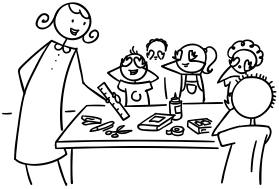
Play “What’s missing?”
This is a fun review memory game – students will have to try to remember review objects from previous lessons (e.g. classroom stationery). Lay the objects out on a table for all to see. Allow the students a minute to memorize the positions of the objects. Remove an object and hold it behind your back. Say, “Open your eyes!” – the first student who can shout out the missing object wins a point for his/her team. Play for all the objects.
Finally, calculate which team has won the most points and give them a round of applause.

Play “Quiz game show”
This is a fun quiz game, like a simple version of a TV game show. Draw some circles on the board and randomly write numbers 1, 2 or 3 in each circle. These will be points.
Put students into teams. Then ask the first team to choose a number – 1 is an easy question (e.g. “Do you like bananas?”) and 3 is a difficult question (e.g. point at a clock and ask, “What time is it?”). 2 will be in between in terms of difficulty. When the question has been answered correctly, erase that number circle. Play until all the number circles are gone – the team with the most points is the winner!
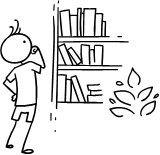
Read a classroom reader again
As you progress through the lessons you will start to build up a catalog of classroom readers (see our Readers download page at https://www.eslkidstuff.com). Kids love going back to old stories and reading through them again. Invite a student to pick a classroom reader and read through it as a class. Make the story as interactive as possible by asking questions (e.g. what [hide_on_uk]colors[/hide_on_uk][hide_on_us]colours[/hide_on_us] there are, the names of different objects, etc.) and getting students to speculate what is going to happen next in the story.

Talk about the weather (do after you have taught the weather lesson plan).
- Prepare a weather board. Before the first class prepare a piece of cardboard and cover it with felt – you are going to pin this to the wall. If you can, try and get blue felt (to represent the sky). Write at the top in large letters, “How’s the weather today?”. Below that write “Today it’s”. Cut out weather pictures (such as our weather flashcards) and stick some velcro on the back. Arrange the weather pictures around the edge of the board and then put the board on the wall of your classroom. You can now use this weather board at the beginning of every lesson.
- Ask about the weather. Ask, “How’s the weather today?” and have students put up their hands. Allow one weather condition per student (e.g. “It’s rainy”) and have each student come up and put a weather picture on the weather board.
- Introduce more weather vocabulary. Depending on weather conditions, you can introduce more weather words (with pictures … you can get students to draw them), such as:
- stormy
- misty
- showery
- freezing
- humid
- frosty
- icy
- drizzly
New learning and practice:
1. Review likes and dislikes
We’ll start off with a quick review and game based on likes and dislikes, a topic which you should have already covered in a previous lesson.
On the board write 4 categories, as follows:
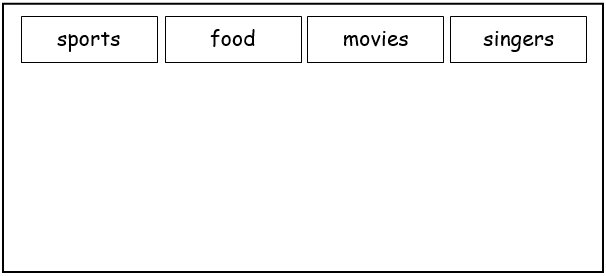
Elicit one example for each category from your class (e.g. sport – golf) and write it under the category. Try to pick out some items you like and dislike.
Next, elicit the question “Do you like …?” and the answers “Yes, I do” and “No, I don’t”. Write them on the board. Then get the students to ask you if you like each of the four items. Answer and draw a happy or sad face next to each item to show that you like or dislike each one.
Finally, ask a student to come to the board. Have students shout out four more items to write out under the categories. Have students ask this student, “Do you like …?” for each item and have the student answer and draw a happy / sad face next to each one. Your board should then look something like this:

Feel free to have other students come to the board and do for them if you think the class needs the practice.
2. Play the “Likes & dislikes category game”
Before class, print out enough card sets (see end of the PDF lesson plan) for each group of 3-4 students. Cut them out and shuffle.
Put students into groups of 3-4 around a table and put the cards face-down in the middle of their table. Model with one group so everyone can see how to play the game.
Student A picks up a card and reads the category to the rest of the group (e.g. “sport”). The other students race to slap the table – the first one can say a sport (e.g. “baseball”). Student A then asks, “Do you like baseball? ” and the student must reply (e.g. “Yes, I do”). That student then gets to read out the next card.
The game should be fast paced and fun. When students have finished let them play again if they enjoyed it.
3. Teach “[hide_on_uk]favorite[/hide_on_uk][hide_on_us]favourite[/hide_on_us] / least [hide_on_uk]favorite[/hide_on_uk][hide_on_us]favourite[/hide_on_us]”
Wipe the board clean. From the class, elicit 8 categories from the previous card game and write them on different parts of the board, so each part of the board has a category. Something like this:
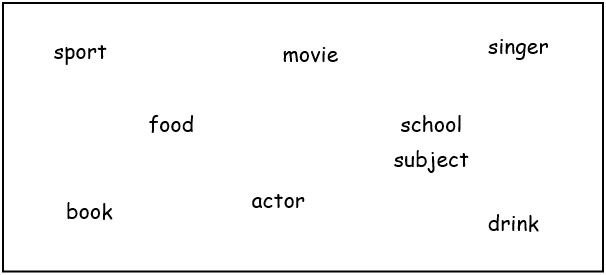
Next, crumple up a piece of paper into a ball. Stand a few paces from the board and throw it at the board. The category that the ball hits (or goes nearest to) is the one you are going to talk about. Start by giving some examples of that category, e.g.
“Food. Hmm. Hamburgers … pizza … cabbage …”
Then smile and say “But … my [hide_on_uk]favorite[/hide_on_uk][hide_on_us]favourite[/hide_on_us] food is ice cream!” (show by smiling and smacking your lips).
Next, go around the class asking what everyone’s [hide_on_uk]favorite[/hide_on_uk][hide_on_us]favourite[/hide_on_us] food is.
Then, pull a sad face and say “My least [hide_on_uk]favorite[/hide_on_uk][hide_on_us]favourite[/hide_on_us] food is cabbage” (show by pulling a disgusted face). Go around the class asking what everyone’s least [hide_on_uk]favorite[/hide_on_uk][hide_on_us]favourite[/hide_on_us] food is.
On the board write the following:
What / Who is your (least) [hide_on_uk]favorite[/hide_on_uk][hide_on_us]favourite[/hide_on_us] …?
My (least) [hide_on_uk]favorite[/hide_on_uk][hide_on_us]favourite[/hide_on_us] … is …
Get a student to volunteer and throw a ball at the board. Then ask, “What/Who is your [hide_on_uk]favorite[/hide_on_uk][hide_on_us]favourite[/hide_on_us] …?” and “What/Who is your least [hide_on_uk]favorite[/hide_on_uk][hide_on_us]favourite[/hide_on_us] …?” and have the student reply using the structures on the board. For example:
Teacher: (the student’s ball has hit “singer”) Who is your [hide_on_uk]favorite[/hide_on_uk][hide_on_us]favourite[/hide_on_us] singer?
Student: My [hide_on_uk]favorite[/hide_on_uk][hide_on_us]favourite[/hide_on_us] singer is Justin Bieber.
Teacher: Good! And who is your least [hide_on_uk]favorite[/hide_on_uk][hide_on_us]favourite[/hide_on_us] singer?
Student: My least [hide_on_uk]favorite[/hide_on_uk][hide_on_us]favourite[/hide_on_us] singer is Taylor Swift.
Finally, pair up students, and get everyone to come up to the board – each pair needs a crumpled up paper ball. Pairs take turns throwing the ball and asking/answering questions about their [hide_on_uk]favorites[/hide_on_uk][hide_on_us]favourites[/hide_on_us]. If you have a lot of students this might be a bit chaotic with balls flying all over the place, but it will be fun!
4. Start the “[hide_on_uk]Favorites[/hide_on_uk][hide_on_us]Favourites[/hide_on_us] questionnaire” worksheet
Get everyone to sit down and give out the worksheet. Ask everyone to fill in the columns for “[hide_on_uk]favorite[/hide_on_uk][hide_on_us]favourite[/hide_on_us]” and “least [hide_on_uk]favorite[/hide_on_uk][hide_on_us]favourite[/hide_on_us]” for themselves (in the “YOU” column). If some students don’t have a [hide_on_uk]favorite[/hide_on_uk][hide_on_us]favourite[/hide_on_us] or least [hide_on_uk]favorite[/hide_on_uk][hide_on_us]favourite[/hide_on_us] for some items they can leave them blank.
Next, draw everyone’s attention to the “why [hide_on_uk]favorite[/hide_on_uk][hide_on_us]favourite[/hide_on_us] ” and “why least [hide_on_uk]favorite[/hide_on_uk][hide_on_us]favourite[/hide_on_us]” columns. In the example for food, the adjectives “delicious” and “horrible” have been added. Chorus these words and show meaning through your actions. Ask a few students if they agree with the examples in the worksheet (pizza is delicious and cabbage is horrible).
Finally, show that there are more options for saying “why” at the bottom of the worksheet. We’ll now look more closely at these options in the next worksheet.
5. Do the “Why? Adjectives” worksheet
Give out the worksheet and chorus each adjective. As you go through each one give an example and ask the students if the word is positive (+) or negative (-). For example:
Teacher: Delicious … Ok, pizza is delicious! Mmmm, yummy! Is ‘delicious’ positive or negative?
Students: Positive!
Teacher: Yes, that’s right! What other food is delicious?
Students: Cake, hotdogs, tacos, etc.
As you go through the adjectives, students mark the positive or negative on their worksheets.
Next, put students in pairs and have them match the categories to the adjectives. Multiple answers are possible here – at the end go through all of the answers and give examples where necessary.
6. Play “Guess the adjective”
Put students in groups of 3 or 4. Start by modeling the activity – choose one of the adjectives from the worksheet and act it out – for example, act out eating pizza and smacking your lips. Students can shout out which adjective they thinking you are acting (e.g. delicious for pizza).
Then in groups, students take it in turns to act out an adjective. Finally, ask some groups to act out their best ones to the whole class.
7. Continue with the “[hide_on_uk]Favorites[/hide_on_uk][hide_on_us]Favourites[/hide_on_us] questionnaire” worksheet
Have students sit back down and take out their first worksheets. Give 5 minutes to fill in their own “why [hide_on_uk]favorite[/hide_on_uk][hide_on_us]favourite[/hide_on_us]” and “why least [hide_on_uk]favorite[/hide_on_uk][hide_on_us]favourite[/hide_on_us]? ” columns. Students can add one or two adjectives for each item. Whilst they are doing this, circulate and check that students are putting correct adjectives in the columns.
When everyone has finished, pair up students. Students can interview each other to complete their worksheets. Before starting, model with a student, as follows:
Teacher: Ok Saki, what is your [hide_on_uk]favorite[/hide_on_uk][hide_on_us]favourite[/hide_on_us] food?
Student: It’s pasta.
Teacher: Oh really? Why is pasta your [hide_on_uk]favorite[/hide_on_uk][hide_on_us]favourite[/hide_on_us] food?
Student: Because it’s delicious!
Then have students interview each other. Circulate as they are doing this and help out with mistakes and pronunciation. Finally, ask each pair to stand up and do one of their items in front of the class.
8. Read classroom reader “Andre asks”
This story practices the structures from today’s lesson. Before class, download and print off the reader “Andre asks”. As you go through each page, point to the pictures in the thought bubbles and elicit what each person might be thinking about. Also, ask lots of questions to students to see what their [hide_on_uk]favorites[/hide_on_uk][hide_on_us]favourites[/hide_on_us] are, for example:
Teacher: (pointing at the picture on page 2) What is this?
Students: Pasta? Spaghetti?
Teacher: It’s spaghetti! Let’s see what they say. (reading) “Hi! What’s your [hide_on_uk]favorite[/hide_on_uk][hide_on_us]favourite[/hide_on_us] food?“ “It’s spaghetti.“ “Really? Why is it your [hide_on_uk]favorite[/hide_on_uk][hide_on_us]favourite[/hide_on_us]?“ “Because it’s delicious!”. Do you like spaghetti, Miguel?
Student: Yes, I do!
Teacher: Is spaghetti your [hide_on_uk]favorite[/hide_on_uk][hide_on_us]favourite[/hide_on_us] food?
Student: No. My [hide_on_uk]favorite[/hide_on_uk][hide_on_us]favourite[/hide_on_us] food is fried chicken.
Teacher: Really? Why?
Student: Because it’s delicious.
Teacher: Good job! How about you, Clara? Do you like spaghetti?
etc.
Get the students really involved in the story by asking lots of questions about the what their [hide_on_uk]favorites[/hide_on_uk][hide_on_us]favourites[/hide_on_us] and least [hide_on_uk]favorites[/hide_on_uk][hide_on_us]favourites[/hide_on_us] are.
As you read through the story, write the phrases on the board that Andre uses to show interest. At the end you should have the following phrases on the board:
- Really?
- Oh yeah?
- Oh yes?
- OK.
- Oh right.
You’ll use these in the final activity.
After reading the story, give out a reader worksheet to each student and read through the story one more time (without stopping for questions, etc.) as students complete the table. Then go through the answers as a class.
Alternatively, watch our video version of the reader (Internet connection required).
9. Do “TV interviews”
In this final activity, students are going to reenact the story from the classroom reader. Put students in groups of 4-6. Have each group elect the TV show interviewer. The other students in the group will answer the questions. If you have any toy microphones, they are a great prop to give out for the TV interviews. You can even make some out of cardboard.
Give the groups 5 minutes to practice their skit – they can choose which categories they will ask about (even new ones!) – they should aim to ask for around 8-10 preferences.
As the students prepare, encourage the interviewer to do the following:
- Introduce the show (e.g. “Hello, I’m Luca and welcome to my TV show “Luca Asks”! Let’s start!”)
- Use the structures from the lessons to ask for [hide_on_uk]favorites[/hide_on_uk][hide_on_us]favourites[/hide_on_us] / least [hide_on_uk]favorites[/hide_on_uk][hide_on_us]favourites[/hide_on_us] and why
- Use the phrases on the board to show interest
Finally, have each group come up to the front of the class and put on their TV show. Do not interrupt, even if there are mistakes. At the end give a round of applause, give lots of praise and then explain any corrections.
Wrap up:
Assign homework: “Family [hide_on_uk]favorites[/hide_on_uk][hide_on_us]favourites[/hide_on_us] questionnaire” worksheet
Students have to interview 2 members of their family, e.g. mother, father, brother, sister, etc.).
Click for wrap up suggestions for the end of your lessons

1. Assign homework
Each week give out a homework worksheet for your students to take home. Hold up the homework worksheet and model how to do it. Give out the worksheets and say, “Put your homework in your bags”.

2. Do “Quick check”
Time to leave the class. Make sure everything is put away and the students have gathered their belongings. Have them line up at the door and place yourself between the door and the students. For each student check one new word or phrase, for example:
- hold up an object or flashcard (such as an item of clothing) and ask, “What’s this?”
- ask a question from the lesson (e.g. “Where do you live?”, “Do you like bananas?”, “Can you play chess?”, etc.)
When they give you the correct answer say goodbye and let them leave. If their answer is wrong, have them go back to the end of the line – they will have to try again once they reach the front!
Other lesson plans
Actions, verbs & tenses:
- Can – for ability
- Morning routines
- Daily routines & times of the day
- Actions – Present continuous
- Future plans using “going to”
- Past tense activities – Regular verbs
- Past tense activities – Irregular verbs: Part 1
- Past tense activities – Irregular verbs: Part 2
Adjectives:
- Describing people
- Describing things
- Comparing things (Comparative adjectives)
- Comparing things (Superlative adjectives)
Adverbs:
Alphabet:
Animals:
Body:
Classroom:
Clothes:
Colors:
Colours:
Directions:
Family:
Feelings & emotions:
Food:
Health & sickness:
Holidays & festivals:
Jobs:
Likes, dislikes & favorites:
Likes, dislikes & favourites:
- Likes & dislikes
- [hide_on_uk]Favorites[/hide_on_uk][hide_on_us]Favourites[/hide_on_us] and asking why
Nature & Our world:
Numbers:
Places & where we live:
Prepositions of location:
Pronouns:
Shapes:
Shopping:
Sports:
Time, days, months, seasons:
Toys:
Transport & travel:
Weather:





